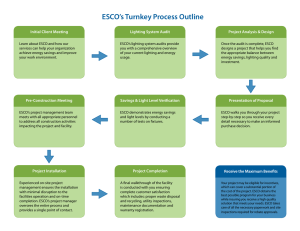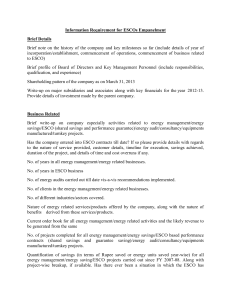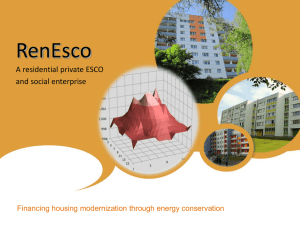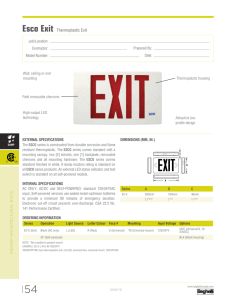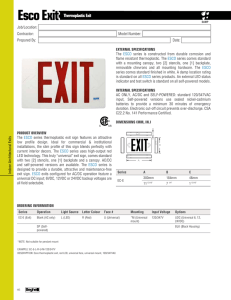Local Financing and the Role of ESCos Presentation
advertisement
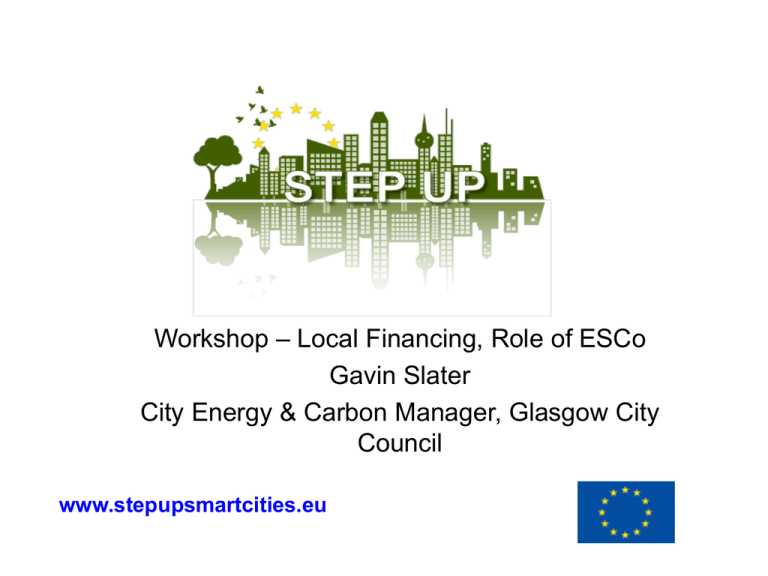
Workshop – Local Financing, Role of ESCo Gavin Slater City Energy & Carbon Manager, Glasgow City Council www.stepupsmartcities.eu District Heating Delivery Structures Option Description Risk allocation Example 1 Entirely public sector funded, operated and owned Public sector retains all risk Purchase contracts for equipment only 2 Public sector led, use of private sector contractors Private sector assumes construction and possibly operation risk Purchase turnkey asset delivery contract, possibly with maintenance and/or operation 3 Private sector invests/takes risk in some elements of the proposed activity Joint venture, equal share in project with a private sector partner Private sector takes risks for discrete elements As 2 with increased private sector operational risk, and payment or investment at risk Joint Venture – both parties investing and taking risk 5 Public funding to incentivise private sector activity Power Purchase Agreement 6 Private sector ownership with public sector promise in element of the project Private sector ownership with only involvement from public sector in facilitation role Public sector support only to economically unviable elements Public sector underpins key risks Private sector risk beyond early stages development Public sector makes suitable site available and grants lease/licence/royalty arrangement Private sector carries all risks No or minimal public sector role 4 7 8 Total private sector owner project Most risks are shared Public sector guarantees demand or credit risk Page 2 ESCo Ownership Models Delivery Structure Description Example Wholly owned public sector Public sector organisation leads the development of the project and takes full financial risk. Aberdeen Heat and Power Elements of the construction and operation are outsourced through turnkey asset delivery contracts. Islington / Bunhill Private sector led development with private sector entity taking full financial risk for the project. Birmingham Residential Social Landlord led project, with RSL taking financial risk for the project. Cube Housing Association Wholly owned private sector Housing scheme Dunfermline Leicester Kings Cross Elements of the construction and operation are outsourced through turnkey asset delivery contracts. Page 3 Key Considerations What influences the delivery structure? •Stakeholder drivers & objectives •Desire for control •Appetite for risk •In-house capacity and capability •Commercial viability •Access to capital / finance •New build or retrofit •Scale & project phasing •Legislation & regulation •Exit strategy Page 4 Risk Perceived Risk Perceived risk often greater than actual What is appropriate level of control? Appropriate risk allocation is key Applicable to all assets? Potential to manage through contracts and performance tools Does control require ownership? Control Page 5 Financing Considerations Delivery structure must be developed alongside funding strategy • Significant upfront capital investment to develop heat networks • Limited public sector capital & competing priorities • May need to attract external finance (public or private) • Main asset (pipework) has a long useful economic life (40+ years) • Difficult to finance network without long-term heat supply agreements • Unregulated market can make revenue streams difficult to guarantee • Project returns are often marginal, with conflict between meeting the strategic aims of a project and creating a commercial market offering • Project development / transaction costs high relative to size of project • Consider bundling smaller schemes to spread risk and reduce overall cost of capital Page 6 The Role of the ESCo An ESCO is JAA! • Public sector arm’s-length vehicle • Private sector EnPC concessionaire • Project specific special purpose vehicle • Joint venture (public-public / public-private) • Form follows function • Consider advantages – focus, risk transfer(?) • And disadvantages – administration, cost, tax • Governance arrangements are critical Page 7 Meeting Public Sector Objectives Option Description Ability to meet public sector objectives Requirement for public funding 1 Entirely public sector funded, operated and owned High Yes 2 Public sector led, use of private sector contractors High Yes 3 Private sector invests/takes risk in some elements of the proposed activity Medium-high Yes 4 Joint venture, equal share in project with a private sector partner Medium Yes 5 Public funding to incentivise private sector activity Medium Yes 6 Private sector ownership with public sector promise in element of the project Medium-low No 7 Private sector ownership with only involvement from public sector in facilitation role Low No 8 Total private sector owner project Low No Page 8 Future Trends What will influence the direction of travel? • Continuing scarcity of public sector capital • Increased public sector capacity to deliver • Increased connection of public sector assets • Increased public-to-public collaboration • Strategic approach: over-sizing / future proofing and bundling of schemes • Regulation – e.g. planning policy, renewable incentive schemes, power purchase • Increasing use of energy service companies • Longer term: separate ownership & control of generation, transmission & distribution assets Page 9 Position in Glasgow Developing the ESCo • Strategic Business Case agreed • ITT for legal, financial, and technical support issued • Appointment of Consultants in Jan 15 • Completion of final business case June 15 • ESCo begins operating July 15 with ‘The Village’ Page 10
